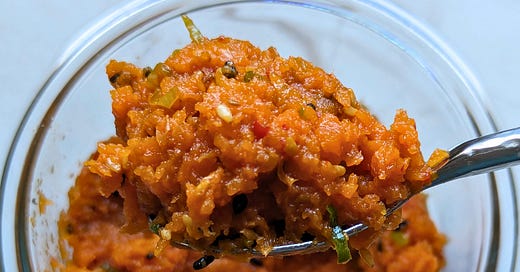Next time you’re at a sushi bar and thinking about ordering a Spicy Tuna Roll, I want you to think twice. Actually, I’ll make it easy for you. Just don’t.
Trust me, this isn’t a plant-based thing. (Though the delicious recipe at the end is.) Believe it or not, this is the same advice I would have given you even when I still ate fish. In fact, back in those days, if I didn’t make the spicy tuna myself or know the sushi chef’s reputation, spicy tuna was a no-go.
My first taste of this wildly popular sushi bar dish was in California during my sushi school days. I was putting in some intern hours at one of the school-owned, swanky sushi bars in Hermosa Beach. I remember standing behind the sushi chefs at the sushi bar, eyes fixed on their precise movements as they worked with pristine cuts of fish from the sushi case. As students, we were mostly there to observe the sushi bar culture or do small prep tasks.
Assistant Sensei, who rarely invited students to do anything beyond watching, suddenly nodded for me to step forward. He retrieved a large chunk of gorgeous tuna and began breaking it down into saku blocks, neatly trimmed, rectangular cuts of fish, perfect for precise slices and uniform nigiri. It must have been my lucky day, because he slid a piece of skin and a spoon my way, motioning for me to carefully scrape the inside of the skin to retrieve the remaining tuna. He even gave me a few sinewy saku blocks to scrape.
Scraping the fatty parts of the tuna next to the skin is a practice rooted in the Japanese principle of mottainai – a deep respect for minimizing waste. This fatty, flavorful scrap is even considered a delicacy, a prized part of the fish that shouldn’t be wasted. After the addition of a few carefully chosen seasonings, Assistant Sensei gave me a little taste on a spoon. I have to admit, it may have been the best thing I’d ever tasted.
That first bite, rich and savory, set a high bar. But as I learned more about the world of sushi, I realized that the spicy tuna most people are eating is a very different story.
The Reality of Spicy Tuna
If the price of that Spicy Tuna Roll you’re eyeing doesn’t make you blink a few times or take a beat, the tuna used isn’t made with the good stuff. Instead, it’s most likely made from a defrosted bag of “tuna scrape.”
What’s tuna scrape? (Yep, it’s about as unappetizing as it sounds). It’s a low-cost, minced fish product injected with dye to stay perpetually neon pinkish red (think hex code #e1385c) and packed with preservatives that alter its texture and shelf life. It’s cheap, convenient, and yes, occasionally linked to food safety scares. The label lists tuna as the ingredient, but that is putting a lot of trust in a processed product that can be had for as little as $5 a pound. Compare that to upwards of $20 per pound for the stuff that goes into the case. I was always suspicious.
Why Sushi Bars Use Frozen Tuna Scrape
You might be wondering why so many sushi bars use this stuff. Cost and consistency. Spicy tuna is usually one of the most popular items on a sushi menu. As a restaurant owner, you can either charge a premium and occasionally risk telling customers you’ve run out of spicy tuna because it’s hard to keep that amount of fresh tuna in house, or you can price it reasonably and keep bags of tuna scrape in the freezer. The manufacturers make it super convenient, packing it thin and flat for easy storage.
And guess what? All of the things you probably love about spicy tuna – the mayo, the seasonings, the sriracha – when used in the right proportions, mask the quality and consistency of the fish.
At my first sushi bar job after graduation, I had full control over how my spicy tuna was made, and I insisted on using fresh tuna. It was a practice that made the rolls more expensive but also made them more delicious.
Compare that to a few years later, when I entered a business partnership where the majority partners insisted on using low quality, frozen tuna scrape. I left that partnership a few short weeks later.
So, the next time you’re at a sushi bar and feel tempted to order a Spicy Tuna Roll, take a moment. If you’re feeling bold, I dare you to ask your sushi chef if they use minced frozen tuna from a bag. Be suspicious if they stall. Very suspicious.
But your best best? Order something else.




Spicy Carrot “Tuna” Recipe
These days, this plant-based Spicy Carrot “Tuna” is my go-to for sushi. Carrots are the perfect stand-in, with a natural sweetness that plays beautifully against the heat in this recipe. Use it in rolls, poke bowls, as a crispy rice topper, or, my absolute favorite, just eat it by the spoonful.
Ingredients
½ lb carrots, peeled and boiled until just tender
1 ½ Tablespoons sriracha
½ teaspoon sesame oil
2 teaspoons scallions, chopped
1 teaspoon sesame seeds
1 teaspoon shichimi togarashi (Japanese 7 flavor pepper), or cayenne pepper
½ teaspoon salt (adjust to taste)
Method
Blend the boiled carrots with food processor until mostly chopped. You’ll want some small chunks for texture.
Stir in sriracha, sesame oil, scallions, sesame seeds, shichimi togarashi (or cayenne), and salt. Adjust seasoning to taste.
Store in the refrigerator up to 3 days.







Made a couple hand rolls with your spicy ‘tuna’ tonight, w/sushi rice, cucumber, carrot, avocado… really delicious!
Our family has always been suspicious of spicy tuna rolls and now I know we were right to be. Thank you for this amazing tidbit of info. And as soon as the time presents itself, I will be trying these spicy carrot rolls!!